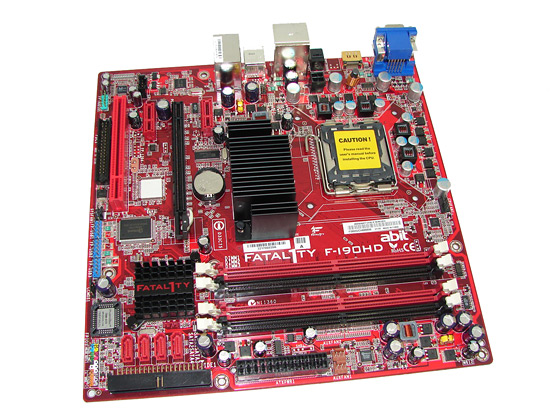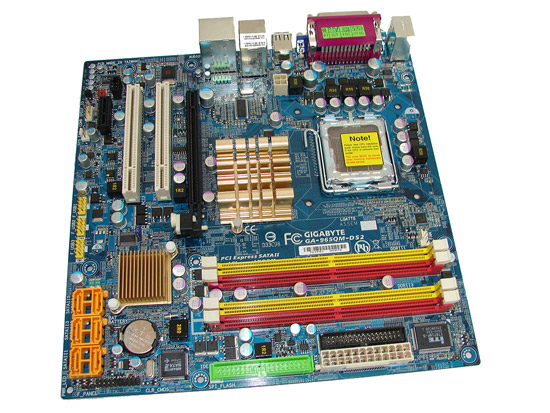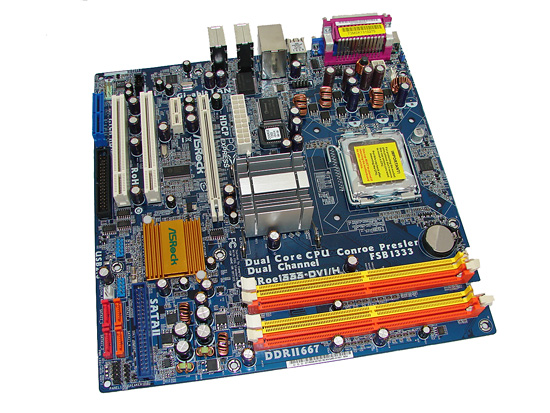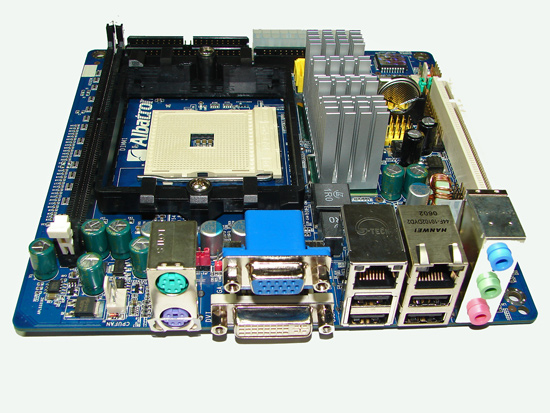Motherboard Products: Intel uATX
The Intel uATX motherboard suppliers have been slow to ramp up production of boards supporting the Core 2 Duo processor but we have several in for testing now based on the Intel G965/Q965 chipsets along with new performance enhancing graphics drivers. We are also expecting a few 946GZ based boards shortly that make a perfect match for the Intel E4xx series of Core 2 Duo processors with an 800MHz front side bus.

The abit Fatal1ty F-I90HD motherboard is based on the ATI Radeon Xpress 1250 and SB600 chipsets featuring the ATI X1250 onboard graphics capability. The board offers support for 16GB of DDR2-533/667/800 memory, four Serial ATA 3Gb/s ports, a single ATA133 IDE connector, Realtek ALC885 Audio, and Gigabit LAN. The board has VGA and HDMI outputs along with support for 10 USB 2.0 ports. This motherboard offers excellent performance for a uATX board with our E6320 CPU reaching 7x366 in the overclocking tests.

One of the more interesting Intel uATX motherboards to show up is the Gigabyte GA-965QM-DS2 that is a full featured product based on the Intel Q965 and ICH8D0 chipsets. The board features a single X16 PCI Express slot, one x1 PCI-Express slot, and two PCI 2.2 slots. There are six Serial ATA 3Gb/s ports with RAID 0, 1, 5, and 10 support, and a single ATA133 IDE connector via a J-Micron chipset. HD Audio is courtesy of the Realtek ALC888, and Gigabit Ethernet supplied by the Nineveh 82566DM chipset. We just received a performance BIOS update and will have overclocking results shortly, but the overall performance of the board has been very good to date.

ASRock has actually supplied us with a few boards for review with the ConRoe1333-DVI/H being the latest board to arrive for testing. The board is based on the venerable Intel 945G and ICH7 chipsets and features a single x16 PCI Express slot, one x1 PCI-Express slot, and two PCI 2.2 slots. There are four Serial ATA 3Gb/s ports and a single ATA133 IDE connector. HD Audio comes from the Realtek ALC888 and Gigabit Ethernet via the Realtek RTL8111B chipset. The board ships with a DVI/HDCP compliant daughter card that utilizes the single x16 PCI Express slot to provide DVI output via the 945G chipset. The board also has a standard VGA port.
AMD Mini-ITX
One of the most interesting motherboards we have seen in the labs recently is the Albatron KI51PV-754 motherboard. We found the performance of this motherboard to be very good overall. The potential market for this system spans from vehicle installations to HTPC to medical/industrial systems. If you are looking for a Mini-ITX board we highly suggest you seriously consider this offering from Albatron.

The board is based on the NVIDIA GeForce 6150 and nForce 430 chipsets. The board supports current socket 754 processors and has a single memory slot for DDR333/400 memory. Audio is provided by the Realtek ALC655 and the board features a Marvell 88E3016 10/100 Fast Ethernet PHY and a Marvel 88E8055 Gigabit LAN chipset. There are four Serial ATA 3Gb/s ports, two ATA133 ports, and a single PCI slot. The board has both a DVI and D-SUB output ports and can support HDTV output capability via an optional cable for the onboard header.
Final Remarks
Although we just briefly went over a few motherboard products, rest assured we have a significant amount of boards that will be reviewed shortly along with some exciting storage, networking, and USB flash drive roundups. We will also be introducing our Vista and Linux benchmarks for our mainstream motherboard reviews.
The Intel uATX motherboard suppliers have been slow to ramp up production of boards supporting the Core 2 Duo processor but we have several in for testing now based on the Intel G965/Q965 chipsets along with new performance enhancing graphics drivers. We are also expecting a few 946GZ based boards shortly that make a perfect match for the Intel E4xx series of Core 2 Duo processors with an 800MHz front side bus.

The abit Fatal1ty F-I90HD motherboard is based on the ATI Radeon Xpress 1250 and SB600 chipsets featuring the ATI X1250 onboard graphics capability. The board offers support for 16GB of DDR2-533/667/800 memory, four Serial ATA 3Gb/s ports, a single ATA133 IDE connector, Realtek ALC885 Audio, and Gigabit LAN. The board has VGA and HDMI outputs along with support for 10 USB 2.0 ports. This motherboard offers excellent performance for a uATX board with our E6320 CPU reaching 7x366 in the overclocking tests.

One of the more interesting Intel uATX motherboards to show up is the Gigabyte GA-965QM-DS2 that is a full featured product based on the Intel Q965 and ICH8D0 chipsets. The board features a single X16 PCI Express slot, one x1 PCI-Express slot, and two PCI 2.2 slots. There are six Serial ATA 3Gb/s ports with RAID 0, 1, 5, and 10 support, and a single ATA133 IDE connector via a J-Micron chipset. HD Audio is courtesy of the Realtek ALC888, and Gigabit Ethernet supplied by the Nineveh 82566DM chipset. We just received a performance BIOS update and will have overclocking results shortly, but the overall performance of the board has been very good to date.

ASRock has actually supplied us with a few boards for review with the ConRoe1333-DVI/H being the latest board to arrive for testing. The board is based on the venerable Intel 945G and ICH7 chipsets and features a single x16 PCI Express slot, one x1 PCI-Express slot, and two PCI 2.2 slots. There are four Serial ATA 3Gb/s ports and a single ATA133 IDE connector. HD Audio comes from the Realtek ALC888 and Gigabit Ethernet via the Realtek RTL8111B chipset. The board ships with a DVI/HDCP compliant daughter card that utilizes the single x16 PCI Express slot to provide DVI output via the 945G chipset. The board also has a standard VGA port.
AMD Mini-ITX
One of the most interesting motherboards we have seen in the labs recently is the Albatron KI51PV-754 motherboard. We found the performance of this motherboard to be very good overall. The potential market for this system spans from vehicle installations to HTPC to medical/industrial systems. If you are looking for a Mini-ITX board we highly suggest you seriously consider this offering from Albatron.

The board is based on the NVIDIA GeForce 6150 and nForce 430 chipsets. The board supports current socket 754 processors and has a single memory slot for DDR333/400 memory. Audio is provided by the Realtek ALC655 and the board features a Marvell 88E3016 10/100 Fast Ethernet PHY and a Marvel 88E8055 Gigabit LAN chipset. There are four Serial ATA 3Gb/s ports, two ATA133 ports, and a single PCI slot. The board has both a DVI and D-SUB output ports and can support HDTV output capability via an optional cable for the onboard header.
Final Remarks
Although we just briefly went over a few motherboard products, rest assured we have a significant amount of boards that will be reviewed shortly along with some exciting storage, networking, and USB flash drive roundups. We will also be introducing our Vista and Linux benchmarks for our mainstream motherboard reviews.










33 Comments
View All Comments
defter - Thursday, May 3, 2007 - link
Why do you think that DDR2 is "crappy" and DDR3 is much better? Both introduce higher bandwidth with the same or slighly higher latencies (compared to previous generation) and lower power consumption.
Biggest advantage of BX was its longlevity, with adapter you can use socket-370 CPUs in slot1 BX motherboard. Current P35 boards will be obsoleted in the next year (or early 2009) by Nehalem based CPUs that will require a new socket.
TA152H - Thursday, May 3, 2007 - link
The strength of the BX was the incredible performance difference it had, even over succeeding generations. Intel came with the 810, 820, 840 and then 815. Only the 840 could touch it, and then in only some benchmarks, and this while using super expensive Rambus in dual channel. Even after it was discontinued, people clamored for this chipset, however obsolete it was, because of the crazy performance of it. VIA couldn't even approach the scores of it either.Any chipset from that time could be fitted with a Slocket and used with later processors. There was nothing unique about the BX from that perspective. And it was replaced just like Intel does with all their chipsets, and even made so it couldn't use the newest processors (remember FCPGA2 and the Tualatin and Coppermine-T). People found ways of using it because the performance was so good. Probably some of it had to do with politics though, Intel may have slowed down the 815 so it wouldn't hurt RDRAM sales. Why else would it be slower than the BX?
markopolo - Thursday, May 3, 2007 - link
„… On May 21st, Intel will launch the P35 chipset …”Intel has brought forward the launch of its Bearlake chipset and, from May 27th to May 9th.